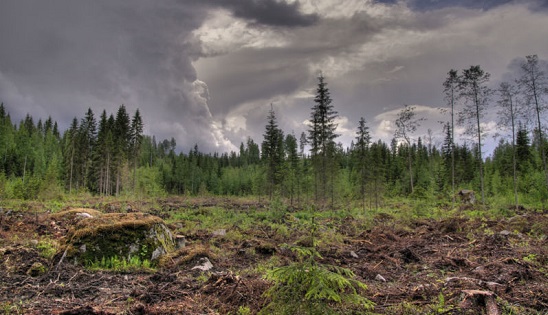 Reforesting would help, but we're still deforesting. Photo: Mikko Muinonen
Reforesting would help, but we're still deforesting. Photo: Mikko MuinonenStory of the Week... Editorial of the Week... El Niño/La Niña Update... Toon of the Week... Quote of the Week... Graphic of the Week... SkS in the News... Photo of the Week... SkS Spotlights... Video of the Week... Report of Note... Coming Soon on SkS... Poster of the Week... Climate Feedback Reviews... SkS Week in Review... 97 Hours of Consensus...
European national science academies report warns tepid emission cuts not enough.
 Reforesting would help, but we're still deforesting. Photo: Mikko Muinonen
Reforesting would help, but we're still deforesting. Photo: Mikko MuinonenThe analysis is well known to everyone who has paid even a little attention: the world hasn’t yet done enough to lessen the impacts of climate change. The last Intergovernmental Panel on Climate Change report included greenhouse gas emissions scenarios that could limit global warming to two degrees Celsius or less, but we’re not even close to a trajectory that would achieve any of them.
But there’s something about those two-degrees scenarios you may not know, which climate scientists have been talking a lot about recently. Those scenarios involved a substantial deployment of technologies to actively remove CO2 from the atmosphere. Without those technologies, we’re even further from sufficient emissions cuts.
That leaves us with a crucial question: can carbon dioxide removal techniques be scaled up to the necessary level in time? A new European Academies Science Advisory Council (EASAC) report—reviewed and endorsed by the national academies of more than two dozen countries—evaluates the outlook for carbon dioxide removal. And it’s not optimistic.
Keeping the world below 2°C of warming needs tech we don’t have by Scott K Johnson, Ars Technica, Feb 5, 2018
Opioids. Fracking. Zika. GMOs. Scientists should be speaking up about all sorts of science-based issues that affect our lives. Especially now, when Trump administration officials tell us that climate change is debatable and that killing African elephants can benefit the herd, scientists should be constantly exposing misinformation, bogus alternative facts and fake science.
Unfortunately, the greatest obstacle to informing the public may be the very universities that many scientists work for.
When Scientific American editors talk with Ph.D. students, postdoctoral researchers and early-career scientists, they often tell us that an adviser or senior department member has instructed them not to write blogs or articles for the general public, speak at public events or talk with reporters and to stay away from social media. In a 2016 survey of 61 chairs of U.S. and Canadian medical departments, only 23 percent said it was important for faculty to participate in blogs hosted by medical journals. Never mind personal blogs and those in the media.
Universities Should Encourage Scientists to Speak Out about Public Issues, Opinion by the Editorial Board of Scientific American, February 2018 Print Edition
Many thanks to Tom for covering my post lastvd month, allowing me to focus on the American Meteorological Society ’s annual meeting (where I talked about the blog, and enjoyed my company on the plane ride home). It’s good to be back, and I’m glad to see our La Niña is still hanging around… although probably not for much longer. In fact, the current ENSO forecast from the Climate Prediction Center and IRI predicts a 55% chance that neutral conditions will be in place by spring 2018. Let’s get to it!
February 2018 La Niña update: tuned in by Emily Becker, NOAA's Climate.gov, Feb 8, 2018
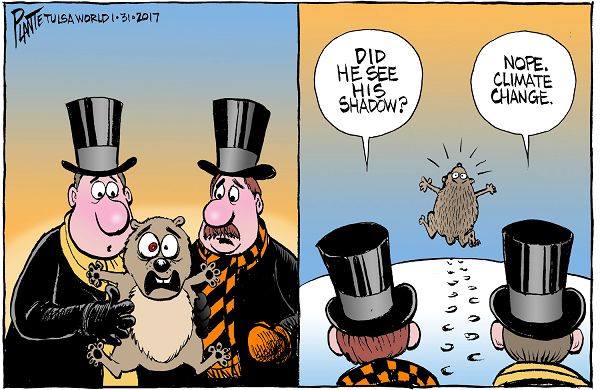
In 2009, a group of prominent doctors and climate scientists gathered in Washington DC for a forum on the psychological dimensions of climate change. Their discussion resulted in the first major report on the subject, which found that although an estimated 200 million Americans will be exposed to "serious psychological distress from climate related events," the US health care system was only "minimally prepared" to address these issues.
"The report is still valid after seven years," Lise van Susteren, a forensic psychiatrist and co-author of the report, told me. "The psychological aspect of climate change was not being discussed at all in 2009, but climate change is increasingly being recognized [as a mental health issue] now."
Climate Change Is Giving Us 'Pre-Traumatic Stress' by Daniel Oberhaus, Motherboard, Feb 4, 2018

Typical impacts of La Niña on U.S. winter temperature and precipitation. Such impacts have been associated with past episodes, but all impacts aren't seen with every episode. Drawing by Fiona Martin. NOAA
La Niña is on its way out. What does that mean for California? by Jacob Margolis, Enviornment & Science, KPCC, Feb 8, 2018
[To be added.]
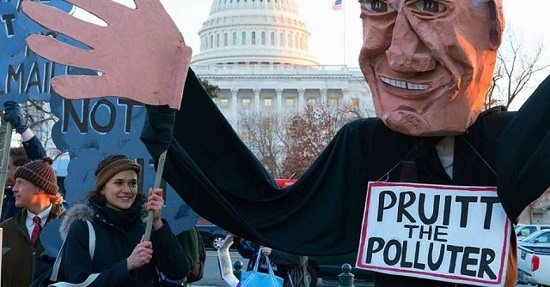
Pruitt Squirming Away From The Weight of Climate Evidence by Rachel Liker (Union of Concerned Scientists), Common Dreams, Feb 9, 2018
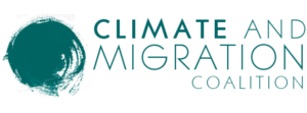
Climate and Mitigation Coalition
Many will be forced from their homes by disasters. Others may want to move as a way of adapting unprecedented change. We exist to protect the rights of anyone facing these circumstances. We fight for humane and empowering policies to protect people who move, and for public acceptance and support.
Our goal is to ensure a people centred policy response at the national and international level by:
We work in several ways in persuit of our aims:
World Economic Forum: weforum.org. Published on Jan 24, 2018.
2017 was one of the hottest years on record. It ranked as the second-warmest by NASA and third-warmest by the National Oceanic and Atmospheric Administration. A major extension of the West Antarctic ice sheet has broken off and Swiss glaciers continue to recede. As the global climate changes and extreme weather events are proving more devastating and expensive, how can affected countries and communities mitigate risk and build long-term resilience? Is there still time to limit warming to two degrees and, if not, how do we adapt?
Today the mechanisms that are used are largely technological – food, water, heat, power – and affect every aspect of our economic and social lives. The future of people and the planet are dependent upon the technological ‘advances’ that are controlled by a few at the expense of the many. What we know about these technologies and the impacts they have on human societies and the planet is largely covered up. The truth is sugar coated and fed to the people, information omitted or falsified and presented as “the news” based on “the facts”. Climate change for example was covered up — denied, falsified, twisted, and spun — so that rich accumulators – individuals and corporations — could keep amassing vast wealth and hold onto political power. Even though they knew the existential risk — that what they were doing was exacerbating the conditions in the biosphere that make it possible for humans to live on Earth.
The cold hard truth is while President Trump and the U.S. Congress are still in denial, the Pentagon is preparing for the social and well as environmental catastrophes that are caused by climate change. So where does the public who care about the children who will be most affected by climate change find the information they need to voice their concerns and plan civil actions? How can countries and communities mitigate risk and build long-term resilience?
A great panel discussion from the 2018 World Economic Forum.
VIDEO: 2018 World Economic Forum Responding to Extreme Environmental Risks, Garn Press, Jan 25, 2018
A new report confirms that negative emission technologies (NETs) offer only “limited realistic potential” to remove large amounts of carbon dioxide from the atmosphere and not at the scale envisaged in some climate scenarios.
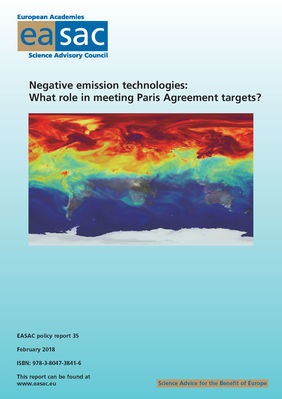 In a new report by the European Academies’ Science Advisory Council (EASAC), senior scientists from across Europe have evaluated the potential contribution of negative emission technologies (NETs) to allow humanity to meet the Paris Agreement’s targets of avoiding dangerous climate change. They find that NETs have “limited realistic potential” to halt increases in the concentration of greenhouse gases in the atmosphere at the scale envisioned in the Intergovernmental Panel on Climate Change (IPCC) scenarios. This new report finds that none of the NETs has the potential to deliver carbon removals at the gigaton (Gt) scale and at the rate of deployment envisaged by the IPCC, including reforestation, afforestation, carbon-friendly agriculture, bioenergy with carbon capture and storage (BECCs), enhanced weathering, ocean fertilisation, or direct air capture and carbon storage (DACCs).
In a new report by the European Academies’ Science Advisory Council (EASAC), senior scientists from across Europe have evaluated the potential contribution of negative emission technologies (NETs) to allow humanity to meet the Paris Agreement’s targets of avoiding dangerous climate change. They find that NETs have “limited realistic potential” to halt increases in the concentration of greenhouse gases in the atmosphere at the scale envisioned in the Intergovernmental Panel on Climate Change (IPCC) scenarios. This new report finds that none of the NETs has the potential to deliver carbon removals at the gigaton (Gt) scale and at the rate of deployment envisaged by the IPCC, including reforestation, afforestation, carbon-friendly agriculture, bioenergy with carbon capture and storage (BECCs), enhanced weathering, ocean fertilisation, or direct air capture and carbon storage (DACCs).
“Scenarios and projections that suggest that NETs’ future contribution to CO2 removal will allow Paris targets to be met appear optimistic on the basis of current knowledge and should not form the basis of developing, analysing, and comparing scenarios of longer-term energy pathways for the EU. Relying on NETs to compensate for failures to adequately mitigate emissions may have serious implications for future generations," state the European science academies.
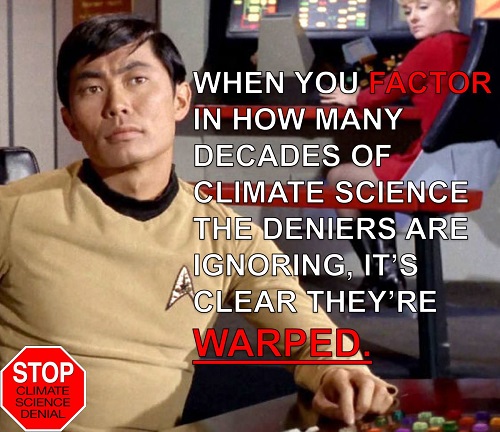
CLAIM
"We know that humans have most flourished during times of, what, warming trends. I think there are assumptions made that because the climate is warming, that that is necessarily a bad thing."
VERDICT

Scott Pruitt, KSNV NBC Las Vegas, 6 Feb. 2018
Unsupported: There is no basis to Pruitt's claim that humans have flourished during past periods of similarly rapid warming. The last 10,000 years, during which human civilization has developed, have seen stable climate conditions.
Misleading: Research unambiguously shows that the net effect of continued climate change this century—factoring in both positives and negatives—is significant harm to humans and the rest of Earth’s ecosystems.
Misrepresents the scientific process: Scientists do not simply assume that warming has dangerous consequences. This is a careful conclusion derived from extensive research.
KEY TAKE AWAY
While some effects of climate change will be beneficial in some locations, the evidence from scientific research very clearly shows that the negative effects vastly outweigh any positives. This is the result of the rapid rate of warming—not a departure from an “ideal temperature” for our planet. Pruitt’s claim that the human contribution to global warming is unclear was evaluated in a previous Claim Review and found to be incorrect.
EPA’s Scott Pruitt incorrectly suggests climate change might not be “a bad thing”, Climate Feedback. Feb 9, 2018
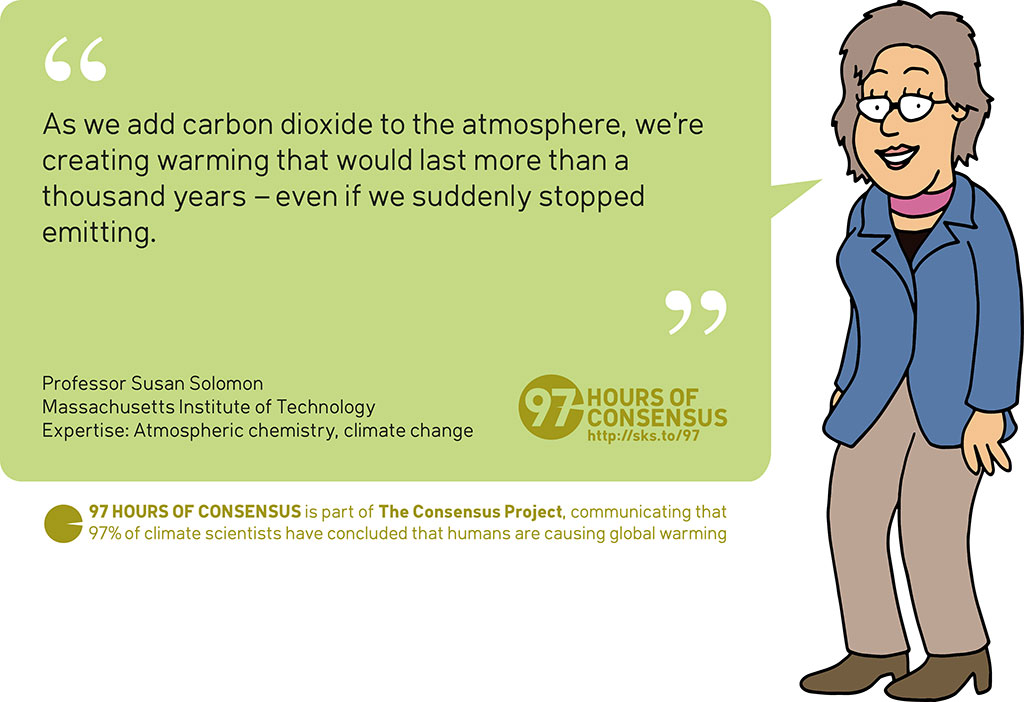
Quote provided by email
High resolution JPEG (1024 pixels wide)
Posted by John Hartz on Sunday, 11 February, 2018
 |
The Skeptical Science website by Skeptical Science is licensed under a Creative Commons Attribution 3.0 Unported License. |